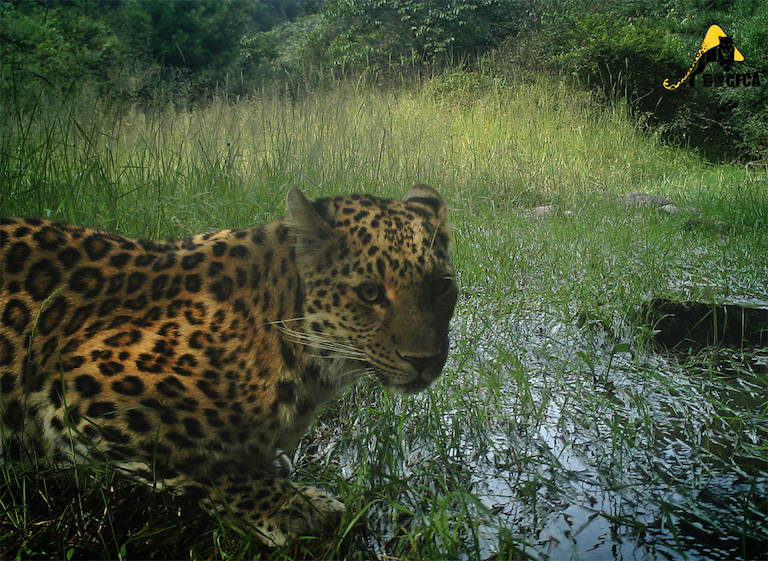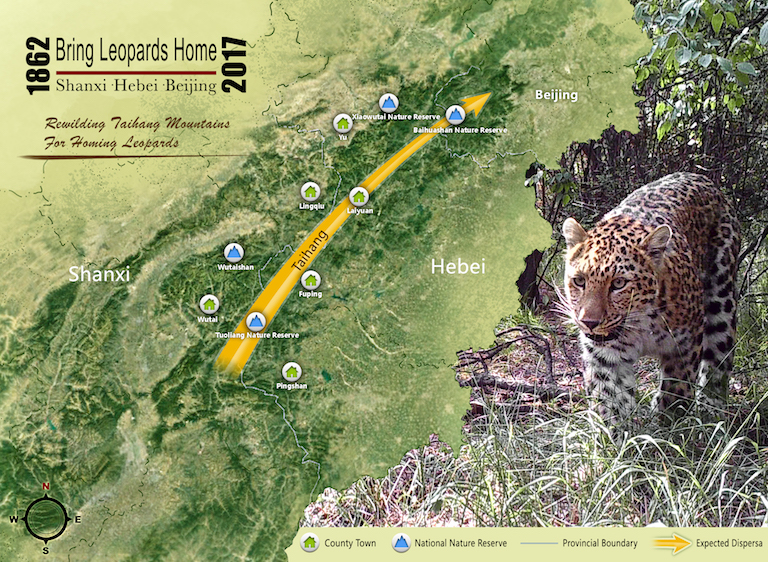- The North China leopard (Panthera pardus japonensis) is one of nine leopard subspecies and an endemic to China.
- The cats’ population has shown signs of revival in certain parts of the country in recent years, according to conservation groups
- However, industrial development and infrastructure construction remain major threats to the integrity of the leopards’ habitat and conflicts with people over livestock in their mountainous territories are intense.
On May 17, a video clip showing the dead body of a North China leopard by the side of a mountain road in China’s eastern Shanxi province went viral. People were surprised to learn that leopards were afoot in Shanxi after an absence of decades.
“From the video image, I can tell it was a subadult male leopard seeking its own territory. And indeed it was too young to have gathered much experience in crossing roads,” Song Dazhao, who manages the leopard project of the NGO Chinese Felid Conservation Alliance (CFCA), commented on social media shortly after the leopard’s death in Lingchuan county.
Three weeks later in Heshun, another county in Shanxi, an elderly woman looking for two missing calves in the mountains near her village bumped into three leopards resting. “It was apparent that these three young leopards had eaten the two calves,” Song told Mongabay. “According to our close monitoring, the three buddies have caused trouble for locals’ livestock frequently this year.”
These two recent incidents neatly illustrate the critical situation faced by the North China leopard (Panthera pardus japonensis), one of nine leopard subspecies and an endemic to China. (Fewer than five dozen individuals belonging to two other leopard subspecies also live in the country.) The cats’ population has shown signs of revival in certain parts of the country in recent years. However industrial development and infrastructure construction remain major threats to the integrity of their habitat and conflicts with people over livestock in their mountainous territories are intense.
According to Song, North China leopards live mainly in the Taihang Mountains, which extend 250 miles along the border between the eastern provinces of Hebei and Shanxi, and also sporadically in and around western Sichuan province in the country’s south. Evidence suggests that sparse populations persist in five other provinces as well.
Leopards as a whole are not faring very well. Historically, the species was widely distributed across Africa and Asia. But according to the most recent IUCN assessment, published in 2015, leopard populations have been “dramatically reduced due to continued persecution with increased human populations, increased illegal wildlife trade, excessive harvesting for ceremonial use of skins, prey base declines and poorly managed trophy hunting.” The assessment states that suitable habitat for the species has been reduced by nearly one-third over the last three leopard generations, or 22.3 years. As a result, the species was upgraded from Near Threatened to Vulnerable status on the IUCN Red List. (The group does not have up-to-date assessments for the nine subspecies.)

Uncertain numbers
Wei Shuanbing, a 51-year-old villager in the Taihang Mountains of Heshun county, has encountered leopards a number of times in his life. Before the mid-1980s, he and other villagers spotted leopards in the surrounding mountains fairly commonly, he told Mongabay in late May.
“But in my memory, since the late 1980s, due to activities including illegal poaching, intensive deforestation, road construction, and coal mining on the Taihang Mountains in Shanxi, the number of leopards has dwindled significantly,” Wei said. “For almost two decades until around the 2000s, I never saw a single leopard.”
Things have started to change in the past few years. According to conservation NGOs, the North China leopard has started to make a slow revival in a few parts of the country as a result of China’s forest conservation efforts and confiscation of private rifles to stop illegal poaching. However, the overall trajectory of the subspecies remains in doubt.
CFCA is among a limited number of research groups studying the North China leopard. The group has been gathering data on the subspecies in an area of nearly 300 square kilometers (116 square miles) in Shanxi province since 2006. It has documented an increase in the number of leopards there since 2013, and estimates that the area is now home to a stable breeding population of 15 to 18 adult leopards, a scenario corroborated by local villagers’ accounts.
Another NGO, Wocheng Institute of Environmental Ecology (WIEE), documented a recent uptick in leopards in other parts of Shanxi province, including Lishan National Nature Reserve and Manghe National Nature Reserve. According to Zhou Zhefeng, WIEE’s director, preliminary research indicates that the leopard population in certain sections of the Taihang Mountains within Shanxi province appears to be healthy.
Wei himself has seen leopards in the mountains surrounding his village in Heshun county a few times lately, most recently in April 2016. “That day at lunch time, when I was plowing my cornfield, I saw an adult leopard walking slowly from one mountain, crossing the road to another mountain,” he said. Although there are frequent cases of leopards attacking livestock in Wei’s village, there have been no attacks on people.
“The comparatively friendly natural environment in the area, with sufficient prey, including not only wildlife but livestock, also contributed to the revival of leopard numbers in this particular region,” Song explained.
However, Zhou of WIEE cautioned that despite the leopard revival in some areas of Shanxi province, the overall situation remains gloomy, given the level of habitat fragmentation caused by road construction.
It is unclear how many North China leopards remain in the country as a whole. Due to a lack of research, there are no reliable estimates, according to Song. The only estimate available, from a 2015 paper in the journal Oryx, indicates that just 174 to 348 North China leopards exist in the wild. The authors describe a dramatic decline from past estimates: a 1998 estimate put the number of individuals belonging to all three leopard subspecies that live in the country at 1,000. And they recommend that the North China leopard be listed as Critically Endangered by the IUCN. However, Song said that paper did not account for at least two major leopard habitats, so determining the actual number of North China leopards will require additional research.
Song also pointed out that the leopard’s migration routes remain unstudied, a situation CFCA plans to begin rectifying by using radio-telemetry tracking in a future study of the population it monitors.
The Shanxi Provincial Forestry Bureau (SPFB) has invited academics to study leopard populations in certain parts of the province. So far, researchers, including WIEE’s team, have helped install camera traps in a much wider region than the one CFCA studies, covering 15 nature reserves totaling 3,660 square kilometers (1,413 square miles). A more accurate understanding of leopard numbers may emerge from that work.


Conflicts and solutions
With the number of leopards up in Shanxi province, human-carnivore conflicts have become a major issue. In Heshun county, for example, leopards attack villagers’ cattle. The price of an adult cow is over 10,000 yuan ($1,449), almost equal to the average annual income of the areas’ residents, so the attacks pose a huge problem for people. In 2015, leopards attacked 48 cows in one town alone, where over 5,000 cows live.
Song told Mongabay that villagers have retaliated by killing leopards, despite the fact that killing them and most other wildlife is illegal under Chinese law.
“Since villagers know well the leopards’ habit of coming back to eat unfinished prey, they would secretly inject poison into the corpse of the lost cattle,” he said. Quite a few leopards have died of poisoning in the area, according to Song.
In 2015 CFCA launched a compensation program for villagers in Heshun county. The next year, the local county government joined in, fully supporting the program financially. The program pays only partial compensation for livestock lost to leopards: 2,000 yuan ($290) for an adult cow and 1,000 yuan ($145) for a calf. “It was not meant for complete compensation, but rather to deter retaliation,” Song said.
In Ganzi prefecture, in China’s southern province of Sichuan, leopards’ attacks on livestock are even more intensive. CFCA expanded its leopard research and compensation project from Shanxi to Sichuan in 2015. According to the Ganzi Forestry Bureau, during three months in 2016 a single village lost 50 yaks to leopards.
“Locals living on Ganzi alpine pastureland are mostly Tibetan ethnic people, and there have been no retaliatory killing cases so far, mostly due to locals’ Buddhism-based benevolent culture. However this superficial peacefulness is likely to change if the situation continues without any resolution,” Song said.
The number of livestock in Ganzi is increasing, so full compensation for losses is unaffordable for the local government, according to Song. It and conservation groups are urgently seeking additional solutions.
“There is no universal measure to solve the human-leopard conflicts in China. Effective protection efforts can only be made through taking into account elements of local culture, religion, or folk beliefs,” Song said.
Back in Heshun county, CFCA also set up a ranger team composed of community members in 2015, which the Heshun county government later endorsed. (Wei Shuanbing is a member.) For a meager monthly salary of 500 yuan ($72.50), the five-member team is responsible for patrolling the mountain area each month to check camera traps and clear illegal hunting snares, as well as for evaluating livestock losses caused by leopards.
Another positive move by the Heshun county government is its latest readjustment of a plan to build a 100-megawatt wind power project in the Taihang Mountains. The initial plan called for a 100-kilometer (62-mile) long road right through leopard habitat, but the government changed the route to protect the cats.
“The project, if constructed according to its initial plan…would seriously destroy the habitat of the leopard population,” Huang Qiaowen, CFCA’s communication officer, told Mongabay.

Rewilding
Historically, the North China leopard lived in the mountains near Beijing, just outside the Taihang range. But rapid urbanization, increasing human activities, and loss of natural prey resulted in the species vanishing from the area sometime in the late 1990s. Then, in winter 2012, a CFCA team surveying for leopards in Xiao Wutai National Reserve in Hebei province about 100 kilometers (62 miles) northwest of Beijing spotted a leopard with a camera trap.
This April, CFCA launched a crowdfunding campaign called “Bring leopards home.” Huang said the campaign aims to restore and protect an area of over 87,000 square kilometers (33,600 square miles), including the Taihang Mountains, in order to allow leopards to move freely. The goal is for leopards to be able to migrate from Shanxi province north to Beijing or south to Henan and Shaanxi provinces. Prior to press time, the campaign had nearly reached its preliminary goal of raising 400,000 yuan ($58,526) to kick off the project.
“The habitat of the North China leopard along the Taihang Mountains is extremely fragmented,” snow-leopard researcher Liu Yanlin of the Chinese Academy of Forestry told Mongabay. Snow leopards (Panthera uncia), an endangered species, are doing comparatively well in western China. But the Taihang Mountains further east, where most North China leopards live, have a longer history of human development and more intensive infrastructure that have been particularly destructive to the natural forest and wildlife, Liu told Mongabay.
In the end, Liu said, both the success of CFCA’s rewilding project and the North China leopard’s fate will rely on the local government and the general public continuing to support conservation of the big cats.
Citations
Laguardia, A., Kamler, J.F., Sheng, L., Chengcheng, Z., Zhefeng, Z., Kun, S. (2015). The current distribution and status of leopards Panthera pardus in China. Oryx. 51(1):153–159.


